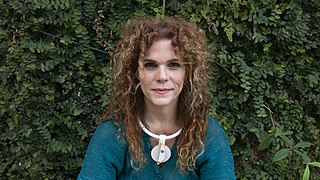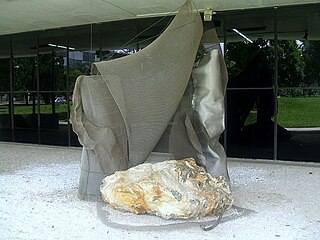Related Research Articles
Brígida Baltar was a Brazilian visual artist. Her work spanned across a wide range of mediums, including video, performance, installation, drawing, and sculpture. She was interested in capturing the ephemeral in her artwork.

Héctor Julio Páride Bernabó was an Argentine-Brazilian artist, researcher, writer, historian and journalist. His nickname and artistic name, Carybé, a type of piranha, comes from his time in the scouts. He died of heart failure after the meeting of a candomblé community's lay board of directors, the Cruz Santa Opô Afonjá Society, of which he was a member.

Hélio Oiticica was a Brazilian visual artist, sculptor, painter, performance artist, and theorist best known for his participation in the Neo-Concrete Movement, for his innovative use of color, and for what he later termed "environmental art," which included Parangolés and Penetrables, like the famous Tropicália. Oiticica was also a filmmaker and writer.

Laura Lima is a contemporary Brazilian artist who lives and works in Rio de Janeiro. Since the 1990s, Lima has discussed in her works the matter of alive beings, among other topics. Her works can be found in the collections of institutions such as Bonniers Konsthall, Stockholm, Sweden; Inhotim Institute, Brumadinho, Brazil; MAM - Museum of Modern Art, São Paulo, Brazil; Migros Museum für Gegenwartskunst, Zurich, Switzerland; Pinacoteca of the State of São Paulo, Brazil; Itaú Cultural, São Paulo, Brazil; Pampulha Museum of Art, Belo Horizonte, Brazil; National Museum of Fine Arts, Rio de Janeiro, Brazil; Hammer Museum, Los Angeles, USA; MASP - Museum of Art of São Paulo, Brazil, among others.

Iole Antunes de Freitas is a Brazilian sculptor, engraver, and installation artist who works in the field of contemporary art. Freitas began her career in the 1970s, participating in a group of artists in Milan, Italy linked to Body art. She used photography. In the 1980s, she returned to Brazil, but abandoned the human body as mediator of her work, adopting the "sculpture body". The artist uses materials such as wire, canvas, steel, copper, stone, and water to create her works.
Waltércio Caldas Júnior, also known as Waltércio Caldas, is a Brazilian sculptor, designer, and graphic artist. Caldas is best known as part of Brazil's Neo-Concretism movement as well as for his eclectic choices in materials.

Franz Josef Weissmann was a Brazilian sculptor born in Austria, emigrating to Brazil while he was eleven years old. Geometric shapes, like cubes and squares, are strongly featured in his works. He was one of the founders of the Neo-Concrete Movement.

Sheila Leirner is a French Brazilian curator, journalist, and art critic, as well as a writer. She was chief curator of the XVIII and XIX São Paulo Art Biennials.

Antonio José de Barros Carvalho e Mello Mourão, known professionally as Tunga, was a Brazilian sculptor and performance artist. Tunga was born in Palmares, Pernambuco, Brazil.
Maria Lynch Rio de Janeiro born 1981 is a Brazilian artist
Dudi Maia Rosa is a Brazilian artist.

Willys de Castro was a Brazilian visual artist, poet, graphic designer, industrial designer, stage designer and magazine editor. De Castro is best known for his "Active object" series and is considered to be a pioneer and founding contributor of the Neo-Concrete Movement.
Hércules Rubens Barsotti was a Brazilian painter, graphic designer, scenographer and costume designer. He was a member of the Neo-Concrete Movement.

Ivan Ferreira Serpa was a Brazilian painter, draftsman, printmaker, designer, and educator active in the concrete art movement. Much of his work was in geometric abstractionism. He founded Grupo Frente, which included fellow artists Lygia Clark, Helio Oiticica, and Franz Weissmann, among others, and was known for mentoring many artists in Brazil.

Elisa Bracher is a Brazilian artist, mostly known for her wooden and stone monumental sculptures, as well as drawings and prints with organic or geometric features.

Wanda Pimentel was a Brazilian painter, based in Rio de Janeiro, Brazil. Her work is distinguished by "a precise, hard-edge quality encompassing geometric lines and smooth surfaces in pieces that often defy categorization as abstract or figurative. “My studio is in my bedroom,” Pimentel said in an interview. “Everything has to be very neat. .. I work alone. I think my issues are the issues of our time: the lack of perspective for people, their alienation. The saddest thing is for people to be dominated by things.”
Marcia Grostein Marcia Grostein is a Brazilian-American artist known for using various mediums across public art, sculpture, painting, video art, photography, and portable wearable art/jewelry. She was the first contemporary Brazilian artist to be acquired by the Metropolitan Museum of Art for the 20th Century Collection by the curator Lowery Sims.
Martha Araújo in Maceió, Brazil is a Brazilian sculptor and performance artist. She lives and works in Maceió the capital of Alagoas in Brazil. The style of her work was performance and sculpture art. She also explored her body with her performances. Her art emerged at the end of a military dictatorship that lasted from 1964 to 1985. She used their experiences during the dictatorship in her artwork to show how they felt trapped. Using textiles Araújo demonstrates the limit of the body through the play between repression and freedom. However, sculptures and performances were not her only interest she has also explored photography and video.

Oskar Metsavaht is a Brazilian artist, academic degree in medicine, fashion designer environmental activist and Amazon guardian. Oskar's work expresses the theme of preserving the forest, water and the empowerment and protection of the peoples of the forest, as an artist, designer and activist. He is founder and creative director of Osklen, a Brazilian fashion brand, recognized as one of the forerunners of the New Luxury concept that strives for the fusion between ethics and aesthetics and advocates conscious fashion through the adoption of sustainable practices. Creative Director of OM.art studio, where he hosts his art studio, an exhibition space and the studio for the development and production of art projects. Metsavaht serves as UNESCO Goodwill Ambassador. Creator of Janeiro Hotel, located in Leblon, Rio de Janeiro. He is also on the advisory board of the Inhotim Institute and board member of Museum of Modern Art (MAM) of Rio de Janeiro. In 2014, Oskar Metsavaht was awarded as Knight of Ordem do Mérito Cultural medal from the Ministry of Culture (Brazil) an honorary order granted by the Federal Government to personalities and institutions that make relevant contributions to Brazil's culture.

Marcela Cantuária is a Brazilian visual artist working primarily with paintings. Cantuária's work revolves around contemporary historical paintings produced in small and large formats. Recurring themes in her work are social movements, political history, feminisms, and environmental causes in Latin America.
References
- ↑ "Frida Baranek". MAM - Museum of Modern Art (in Brazilian Portuguese). Retrieved 27 March 2024.
- ↑ "Frida Baranek | Island Press". islandpress.samfoxschool.wustl.edu. Archived from the original on 11 January 2018. Retrieved 8 April 2018.
- 1 2 3 "Frida Baranek | National Museum of Women in the Arts". nmwa.org. Archived from the original on 6 March 2018. Retrieved 8 April 2018.
- 1 2 "About". Frida Baranek. Retrieved 26 January 2020.
- 1 2 Hoptman, Laura J. (2 April 2015). "Frida Baranek". Archived from the original on 2 April 2015. Retrieved 8 April 2018.
- 1 2 "Paulo Herkenhoff | Frida Baranek". Frida Baranek. Archived from the original on 8 April 2018. Retrieved 8 April 2018.
- ↑ "Island Press Frida Baranek". kemperartmuseum.wustl.edu. Archived from the original on 3 March 2016. Retrieved 8 April 2018.
- ↑ "Roger Cohen: My Life in Media". The Independent. 12 February 2007. Retrieved 26 January 2020.
- ↑ Cecilia Puerto (1996). Latin American women artists, Kahlo and look who else: a selective, annotated bibliography. Greenwood Publishing Group. ISBN 978-0-313-28934-7.
- ↑ Rodrigo Naves; Raquel Arnaud (2005). Raquel Arnaud e o olhar contemporâneo. Editora Cosac Naify. ISBN 978-85-7503-440-8.
- ↑ "Solo Show by Frida Baranak at MAM-Rio". PIPA Prize (in Brazilian Portuguese). 29 November 2013. Retrieved 27 March 2024.
- ↑ "Reflections on the Horizon". Art Basel (in Brazilian Portuguese). Retrieved 27 March 2024.
- ↑ "Liminaridade". Galeria Raquel Arnaud (in Brazilian Portuguese). Retrieved 27 March 2024.